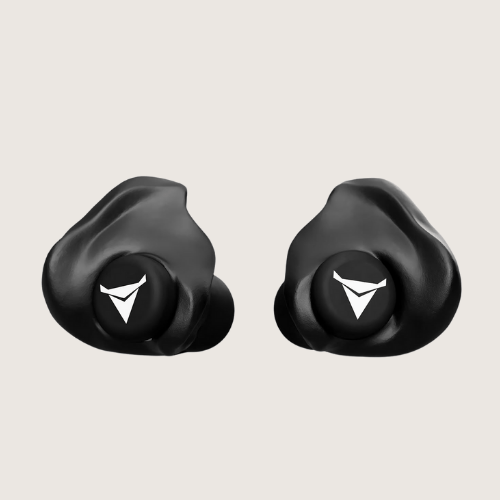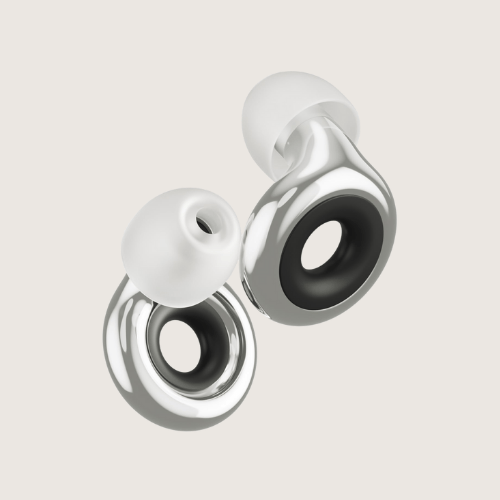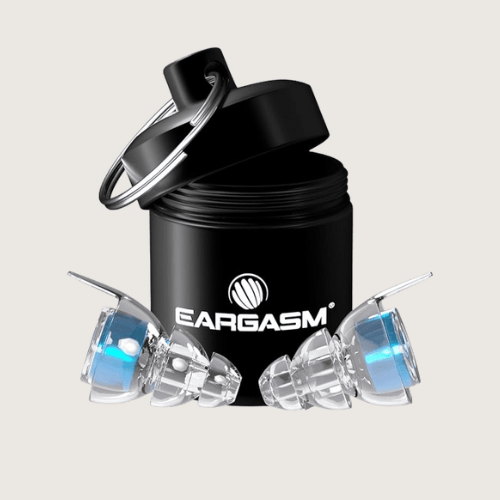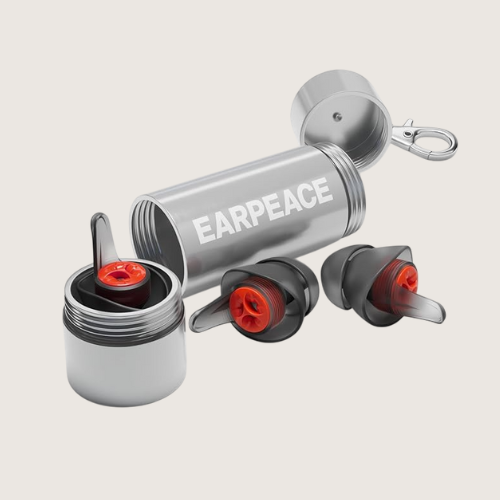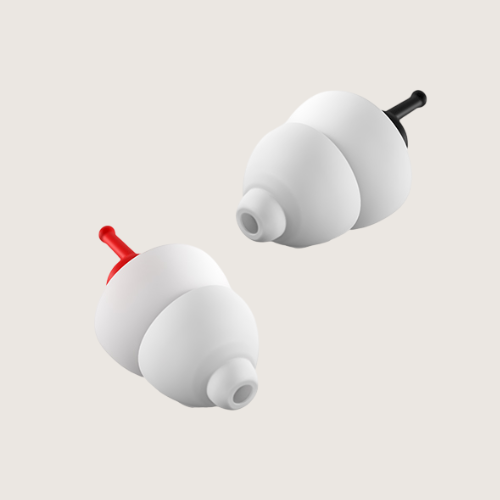As an audiologist, I’ve seen how often motorcycle riders underestimate the impact of wind and engine noise.
Even with a full-face helmet, sound levels can reach over 100 decibels at highway speeds - enough to damage hearing in under 30 minutes.
The good news is that you don’t have to give up situational awareness to protect your ears. The right earplugs reduce harmful noise while still letting you hear sirens, horns, and the road around you.
Whether you’re commuting or riding long distances, hearing protection is one of the simplest and most effective upgrades you can make.
👇 Here’s what to know before you gear up.
- Motorcycle wind noise often exceeds 100 decibels, especially at highway speeds, which can lead to permanent hearing loss without protection
- Earplugs designed for motorcyclists lower harmful noise levels while still allowing you to hear important sounds like traffic, sirens, and conversations
- Helmet compatibility matters - all recommended earplugs in this guide are low-profile enough to fit comfortably under tight or full-face helmets
- You’ll find a range of options, including reusable models with interchangeable filters, discreet styles in multiple sizes, and custom-molded designs for maximum comfort
- 50+ hearing aid brands reviewed and rated by our team of hearing aid wearers and audiologists
- 200+ hours each month spent researching brands and care options
- 2,000,000 people shopped on Soundly in 2024
- 100% independently owned and operated
Read more about our company, services and process here.
Featured in this article
👇 These are our top picks for motorcyclists who want hearing protection that fits comfortably under a helmet and doesn’t block out the road.
Decibullz Custom Molded Earplugs
- Custom Fit: Thermo-fit design molds to your ears for a secure and comfortable fit.
- Clear Sound: High-fidelity filters reduce volume without distorting audio quality.
- Reusable & Remoldable: Can be reshaped multiple times to maintain a perfect fit.
- Stable in Use: Won’t fall out during concerts, sports, or active movement.
The Decibullz High-Fidelity Custom Molded Earplugs combine tailored comfort with reliable hearing protection, making them a practical pick for users needing long-wear earplugs that don’t distort sound.
- The moldable design allows for a secure, personalized fit that stays in place, offering comfort and stability for extended use—whether at concerts, sporting events, or noisy workspaces.
- A built-in high-fidelity filter reduces volume without muffling clarity, helping preserve natural sound quality while protecting your ears from prolonged exposure to loud noise.
These earplugs are especially well-suited for people who want to protect their hearing without sacrificing audio detail or comfort.
- Secure, Custom Fit: Many users highlight the personalized molding process as a game-changer, noting the earplugs stay put even during long events or active use.
- Comfortable for Long Wear: The soft material and tailored fit make them comfortable for hours, with fewer pressure points compared to standard earplugs.
- Clear, Natural Sound: Users consistently praise the high-fidelity filters for preserving audio clarity while still lowering overall volume—especially appreciated at concerts and shows.
- Reusable and Remoldable: Buyers like that the earplugs can be reshaped if the first fit isn’t quite right, adding long-term value.
- Effective Noise Reduction: While not designed to block all sound, users report a noticeable drop in volume that protects hearing without feeling cut off.
Most agree they offer a strong mix of comfort, sound clarity, and reliable protection.
- Molds to the unique shape of your ear for lasting comfort
- Includes multiple tip sizes for different ear shapes
- Fully remoldable for repeat use
- Stays in place even during physical activity
- Comes with a compact carrying case for portability
- Molding process may take practice to get right
- Not designed for complete noise isolation
- Fit quality depends on proper setup and reshaping
- May not suit users seeking maximum noise blocking
Loop Experience 2 Plus
- Safe Sound Experience: Reduces volume by 17 dB while keeping music and voices clear.
- Optional Extra Reduction: Includes a removable Loop Mute for added noise control when needed.
- Secure, Comfortable Fit: Comes with 4 upgraded ear tip sizes for better comfort and fit.
- Reusable and Travel-Ready: Durable, easy to clean, and includes a carry case for portability.
The Loop Experience 2 Plus earplugs offer stylish, reusable hearing protection designed for live music lovers who want to lower volume without losing clarity.
- With 17 dB noise reduction (plus an extra 3 dB using the removable Mute accessory), these earplugs help reduce sound to safer levels while preserving crisp, clear audio—ideal for concerts and festivals.
- A customizable fit with four upgraded ear tip sizes ensures all-day comfort and a secure seal, even for users with smaller ears or during active use.
Thanks to their sleek look, certified hearing protection, and user-friendly design, the Loop Experience 2 Plus is a smart option for anyone wanting to enjoy live sound without the risk of overexposure.
- Clearer Sound at Lower Volumes: Many users report that the Loop Experience 2 Plus effectively lowers volume without muffling voices or music, making conversations and live sound clearer at a safer level.
- Comfortable for Long Wear: The upgraded ear tips earn praise for comfort and secure fit, even during extended use or active movement.
- Concert-Ready Performance: The earplugs are a popular choice for concerts and festivals, where users say they reduce harsh noise without compromising enjoyment of the music.
- Stylish and Functional: The bold design and color options stand out, with some users appreciating how well they complement outfits while providing reliable noise protection.
- Limited Use for Sleep: A few users note these earplugs aren’t ideal for blocking out snoring or sleeping use, especially in very loud environments.
- Reduces sound without sacrificing audio clarity
- Includes Loop Mute accessory for customizable noise control
- Comfortable for long periods, even in smaller ears
- Sleek design that stays in place during active use
- Certified hearing protection for peace of mind in loud settings
- May not block enough sound for sleeping or very loud environments
- Initial fit may require experimentation with different tip sizes
- Not ideal for users seeking complete silence
- Slight learning curve with Mute accessory for new users
Eargasm High Fidelity Earplugs
- Even Sound Reduction: Lowers volume across all frequencies while preserving clarity.
- All-Day Comfort: Comes with two ear tip sizes to improve fit and reduce ear fatigue.
- Everyday Versatility: Works well for concerts, motorcycles, and other loud environments.
- Portable Design: Includes a waterproof metal case for easy storage and travel.
The Eargasm High Fidelity Earplugs strike a strong balance between hearing protection and sound clarity, making them a solid choice for concerts, events, or anyone sensitive to noise.
- Even sound reduction helps preserve clarity, thanks to attenuation filters that lower volume without distorting the full spectrum of sound—ideal for live music or high-noise environments where communication still matters.
- Two silicone shell sizes and a discreet, portable case make these earplugs easy to carry and comfortable for most ear shapes, with a durable metal case adding practical value for on-the-go use.
Designed for versatility, from musicians to commuters, the Eargasm High Fidelity Earplugs offer a thoughtful mix of clarity and protection without compromising everyday usability.
- Clearer Sound, Less Ringing: Users consistently say the earplugs reduce volume without muffling, making live shows and motorcycle rides more comfortable without sacrificing audio detail.
- Reliable Fit for Long Wear: Many report a secure, comfortable fit - even during long concerts or multi-hour motorcycle rides with no slipping or irritation.
- Conversation-Friendly: Several users mention being able to hold normal conversations during breaks at loud events, avoiding the need to remove the plugs.
- Great for Motorcyclists: Riders highlight reduced wind noise while maintaining the ability to hear engine cues and helmet speaker audio, leading to a more relaxed experience on the road.
- Durable, Travel-Ready Case: The included metal case gets praise for being sturdy and heat-resistant, making it easy to keep earplugs safe on the go.
Overall, users appreciate the balance of protection and clarity, especially in loud settings where total sound blockage isn’t ideal.
- Reduces volume while maintaining sound detail and speech clarity
- Comfortable for extended wear thanks to soft silicone tips
- Includes two sizes of ear tips for better fit across users
- Aluminum case is durable and heat-resistant for daily use
- Effective for a wide range of activities including music and riding
- May not be ideal for users with very small ear canals
- Can slightly reduce audio quality in quiet settings
- Higher price point than basic foam alternatives
- No volume adjustability beyond the fixed attenuation level
Earpeace Moto Pro
- Wind Noise Control: Reduces noise levels by up to 24dB to help protect hearing at high speeds.
- Helmet-Friendly Fit: Low-profile, double-cone design fits comfortably under most helmets.
- Clearer Sound: High-fidelity filters block harmful noise while keeping important sounds audible.
- Two Size Options: Includes standard and large tips to help achieve a better seal and fit.
The Earpeace Moto Pro earplugs are designed specifically for motorcyclists looking to reduce wind and road noise without sacrificing comfort or awareness. Built with long rides in mind, these earplugs aim to protect hearing while keeping communication clear and gear fit uninterrupted.
- Up to 24dB of noise reduction helps protect your ears from wind and engine noise at highway speeds, supporting both hearing health and rider focus during long journeys.
- Soft silicone design with a low-profile double cone shape fits comfortably under a helmet, making them suitable for extended wear without pressure or irritation.
Tested to US and EU standards and trusted by professional teams, the Moto Pro delivers solid performance in a compact, rider-friendly form. It’s a dependable option for those who want hearing protection that doesn’t get in the way.
- Effective Wind Noise Reduction: Riders consistently note that these earplugs cut down wind noise significantly, especially at highway speeds, making rides more comfortable and less fatiguing.
- Still Hear What Matters: While they reduce overall volume, users report they can still hear music and traffic sounds - just at a more comfortable level.
- Fits Most, but Not All: Many users find the plugs easy to insert and remove, though some with smaller ears mention a tight or slightly uncomfortable fit during longer rides.
- Convenient Storage with a Flaw: The aluminum case is appreciated for durability and portability, though a few users mention a lopsided design that can make retrieving earplugs tricky.
- More Comfortable Than Foam: Compared to basic foam plugs, these offer clearer sound and a more secure fit, though not dramatically different in performance.
Overall, users find these earplugs well-suited for motorcyclists who want to protect their hearing without sacrificing awareness.
- Reduces wind and engine noise without blocking important sounds
- Comfortable enough for extended wear during long rides
- Compact aluminum case is easy to attach to gear
- Includes two earplug sizes for a more personalized fit
- May be too large for users with smaller ear canals
- Some find the carry case unevenly designed and tricky to use
- Slight reduction in music clarity reported by some users
- Extended wear may become slightly uncomfortable for sensitive ears
Alpine MotoSafe Pro
- Dual Filters: Includes Tour and Race filters for flexible noise reduction.
- Helmet-Friendly Fit: Soft design stays comfortable under tight helmets.
- Hearing Protection: Helps prevent long-term damage from wind and engine noise.
- Still Hear Essentials: Keeps communication systems and traffic sounds audible.
The Alpine MotoSafe Pro is a motorcycle-specific earplug set designed to reduce wind and engine noise while preserving situational awareness. It comes with two interchangeable filter types, giving riders flexibility depending on the noise levels of their journey.
- Dual filter options offer customizable protection, letting you switch between medium and high attenuation based on your riding conditions—ideal for both daily commutes and longer highway trips.
- Soft, helmet-friendly design enhances comfort, using Alpine’s pressure-free material that adapts to your ear canal without causing irritation, even on extended rides.
This option strikes a balance between hearing protection and on-road awareness, making it well-suited for riders who want to protect their hearing without cutting off essential sounds like traffic or communication systems.
- Noticeable Wind Noise Reduction: Riders consistently praise the Alpine MotoSafe Pro for significantly cutting down wind noise, especially at higher speeds, helping protect long-term hearing without muting important sounds.
- Comfortable Under Helmets: Users highlight the soft, adaptable material that fits snugly without pressure, staying in place even when putting on or removing a helmet.
- Intercom and Music Friendly: Many say these earplugs strike a solid balance—blocking harsh wind and engine sounds while still allowing them to hear helmet speakers or intercoms clearly.
- Some Fit Adjustment Required: A few users note that it takes practice to insert them correctly, and they may slowly loosen over time, but most find the learning curve worth it.
Overall, these earplugs are a dependable choice for motorcyclists looking to reduce fatigue and protect hearing without losing situational awareness.
- Two filter options let you choose the right noise level for your ride
- Soft, pressure-free material enhances long-term comfort
- Maintains awareness of surroundings and helmet audio
- Hypoallergenic and silicone-free for sensitive ears
- Compact case and grip tool make handling easier
- Fit can take practice to get right
- May slowly loosen during long rides
- Less effective wind noise reduction compared to some alternatives
- No electronic noise cancellation or music playback features
Assessing Motorcycle Noise Levels
Some riders may argue their motorcycles aren't "that loud." Not all motorcycles are created equal when it comes to noise production.
For example, a Harley-Davidson bike right off the assembly line is approximately 80 dBA.
For comparison, a Ford F-450 truck idles at about 50 dBA. The thing is, users sometimes alter their bikes exhaust to be louder, some reaching levels of 110 dBA (or more).
However, it's crucial to remember that the risk of noise-induced hearing loss is not solely linked to the motorcycle's engine noise.
When riding a motorcycle, one is exposed to various other sounds. The roar of passing vehicles, the whistling of the wind as it blows past your helmet, and the ambient noise of your surroundings all contribute to the overall noise level.
These additional sound sources can combine to create a severe risk to your hearing health, even if your motorcycle's engine is relatively quiet.
It's vital, therefore, to appreciate the cumulative impact of these sounds on your ears. Check out a decibel meter app to check your bike’s noise output.
In short…
Most riders should consider hearing protection regardless of the bike-type they ride.
What are your options?
Understanding hearing protection options for motorcycles is essential for maintaining good hearing health. There are a variety of options available to motorcyclists. Earplugs are the most commonly used form of protection.
They are inexpensive, portable, and come in disposable and reusable types. There are even custom-molded earplugs designed to fit your ear canal perfectly. It's crucial to find what works best in reducing noise exposure while still allowing you to hear essential sounds for safe riding.
Misconceptions About Helmets and Hearing Protection
A common misconception among motorcyclists is the belief that simply wearing a helmet provides sufficient hearing protection. It's crucial to understand that while helmets offer some level of noise reduction (5-7 dB), they are not designed primarily for this function and offer much less protection than earplugs (15-20 dB).
Helmets protect the rider's head from physical injury, and their ability to diminish noise is limited. The noise levels experienced when riding a motorcycle often significantly exceed what a standard helmet can dampen. Hence, relying solely on a helmet for hearing protection can lead to a false sense of security and potentially contribute to long-term hearing damage.
Noise Cancelling Headphones: A False Sense of Protection?
Many people may think of using noise-canceling headphones as a solution to protect their hearing while riding a motorcycle. After all, these devices employ technology that actively reduces environmental noise. They work by analyzing the environment and emitting a sound wave that is 180 degrees out-of-phase. This counteracts the movement of air particles, effectively reducing the perceived noise. Wearing something in the ear will passively reduce noise.
However, a significant limitation exists when considering noise-cancelling headphones for hearing protection. This technology is most effective at lower frequencies. It does not have the same noise reduction capability at higher frequencies, which are quite common in the cacophony of sounds experienced when riding a motorcycle. As a result, noise-canceling headphones cannot effectively reduce noise to the level that dedicated hearing protection devices, such as earplugs, can.
Additionally, some state laws require that a rider cannot wear headphones in both ears while riding a motorcycle and that one ear must be free. Therefore, it's crucial to understand that relying on noise-canceling headphones for hearing protection on a bike can lead to inadequate protection, potentially resulting in hearing damage over time. It's always recommended to use proper hearing protection that's designed explicitly for high-noise environments.
What to Consider
There are several factors to consider when choosing the right type of hearing protection for motorcycling. Let's get to the most important points when selecting hearing protection.
Selecting the Right Hearing Protection
- NRR (Noise Reduction Rating): The effectiveness of hearing protection is measured by its Noise Reduction Rating (NRR). The higher the NRR, the greater the level of noise reduction. Therefore, when choosing hearing protection, look for a device that offers an NRR to ensure maximum effectiveness in safeguarding your hearing while preserving awareness of emergency vehicles.
- Comfort: Just as important as the NRR is the device's comfort. If a device is uncomfortable, you're less likely to use it consistently. Therefore, find a hearing protection device that offers a snug fit and doesn't compromise on comfort. This will ensure you're more likely to use it every time you ride.
- Fit: Different forms of hearing protection fit in different ways. Some are designed to fit directly in the ear canal, while others cover the entire ear. Regardless of the design, it's crucial to ensure proper fit. A device that doesn't fit correctly won't provide optimal protection and could even become a distraction while riding. Therefore, seek a device that works well and stays in place, even during long rides.
- Durability: Earplugs are made from various materials, with foam earplugs designed for single use, while silicone is reusable. It's essential to care for the earplugs as per the manufacturer's recommendations, replacing ear tips or entire earplugs when necessary. Ensure the device you choose is durable enough to withstand the rigors of motorcycling.
Final Thoughts
Remember, the right choice for you will depend on your individual needs and preferences, so be sure to consider factors such as comfort, noise reduction capabilities, compatibility with your helmet, and ease of maintenance.
In sum, proper hearing protection is instrumental for every motorcyclist, offering a shield against potential hearing damage due to pervasive noise levels while riding. The perfect earplug will provide apt sound reduction, comfort, and durability and fit well with your helmet.
With a wide range of options available, including the Eargasm High-Fidelity Earplugs, Custom Molded Earplugs by Decibullz, and the Loop Experience Plus 2, each with their unique properties, motorcyclists can select the protection best suited to their specific needs. Remember, your ears are as important as the thrill of the ride, so ensure you gear up completely before you hit the road.



